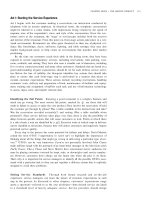Consumer behavior and marketing strategy 12e hawkins motherbaugh chapter 02
Bạn đang xem bản rút gọn của tài liệu. Xem và tải ngay bản đầy đủ của tài liệu tại đây (46.43 MB, 30 trang )
CHAPTER
02
CrossCultural
Variations in
Consumer
Behavior
McGraw-Hill/Irwin
Copyright © 2013 by The McGraw-Hill Companies, Inc. All rights reserved.
PART II: EXTERNAL INFLUENCES
2-2
Learning Objectives
L0
1
Define the concept of culture
L0
2
Describe core values that vary across culture and
influence behaviors
L0
3
Understand cross-cultural variations in nonverbal
communications
L0
4
Summarize key aspects of the global youth culture
L0
5
Understand the role of global demographics
L0
6
List the key dimensions in deciding to enter a foreign
market
2-3
Consumer Behavior In The News…
Changing Global Demographics
Can you guess what percent of purchasing
power is held by Japanese consumers in the
50+ age category?
25%
45%
65%
80%
Source: “In Asia, Markets Pay Heed to a Growing Older Population,” Advertising Age, October 17, 2011, p. 10.
2-4
Consumer Behavior In The News…
Changing Global Demographics
Percent of purchasing power held by Japanese
consumers in the 50+ age category?
80%: If you said 80% you were correct!
Mirrors aging Baby Boom in United States.
“Easier-to-Use” products key.
BUT: Electric guitars a big hit too!!!
Can you relate this to the popularity of karaoke
as business socializing tool in Japan?
Source: “In Asia, Markets Pay Heed to a Growing Older Population,” Advertising Age, October 17, 2011, p. 10.
2-5
Marketing Across Cultural Boundaries is a
Difficult and Challenging Task
2-6
Video Application
The following Video Clip demonstrates
how Oreo adapts globally to “be the
number one cookie in the world.”
2-7
2-8
Globalization
Globalization changing from
One-way influence from U.S. to other countries to…
Mutual influence
Four major
world citizens
Global
citizens
Global dreamers
Antiglobals
Global agnostics
2-9
The Concept of Culture
Culture is the complex
whole that includes
knowledge, belief, art,
law, morals, customs,
and any other
capabilities and habits
acquired by humans as
members of society.
2-10
The Concept of Culture
Cultural values give
rise to norms and
associated sanctions,
which in turn influence
consumption patterns.
Cultures are not static.
They typically evolve
and change slowly over
time.
2-11
Variations in Cultural Values
The numerous values that differ across
cultures and affect consumption include:
Other-Oriented Values
Environment-Oriented Values
Self-Oriented Values
2-12
Variations in Cultural Values
Other-Oriented Values
Individual/Collective
Youth/Age
Extended/Limited Family
Masculine/Feminine
Competitive/Cooperative
Diversity/Uniformity
2-13
Variations in Cultural Values
Environment-Oriented Values
Cleanliness
Performance/Status
Tradition/Change
Risk taking/Security
Problem solving/Fatalistic
Nature
2-14
Variations in Cultural Values
Self-Oriented Values
Active/Passive
Sensual gratification/Abstinence
Material/Nonmaterial
Hard work/Leisure
Postponed gratification/Immediate gratification
Religious/Secular
2-15
Applications in Consumer Behavior
Sensual Gratification/Abstinence
Ad for Calvin Klein
underwear:
OK in U.S. and
France.
Not appropriate in
cultures that place a
high value on
abstinence.
2-16
Cultural Variations in Nonverbal
Communications
2-17
Cultural Variations in Nonverbal
Communications
Time
The meaning of time varies
between cultures in two major
ways:
• Time perspective
• Time Interpretations
2-18
Cultural Variations in Nonverbal
Communications
Space
• Overall use and meanings
assigned to space vary
widely among different
cultures
2-19
Cultural Variations in Nonverbal
Communications
Symbols
Colors, animals, shapes,
numbers, and music have
varying meanings across
cultures.
Failure to recognize the
meaning assigned to a symbol
can cause serious problems!
2-20
Cultural Variations in Nonverbal
Communications
2-21
Cultural Variations in Nonverbal
Communications
Relationships
How quickly and easily do cultures
form relationships and make friends?
• Americans tend to form relationships
and friends quickly and easily.
• Chinese relationships are much
more complex and characterized by
guanxi.
2-22
Cultural Variations in Nonverbal
Communications
Agreements
How does a culture ensure
business obligations are
honored? How are
disagreements resolved?
Some cultures rely on a legal
system; others rely on
relationships, friendships, etc.
2-23
Cultural Variations in Nonverbal
Communications
Things
The cultural meaning of things
leads to purchase patterns that one
would not otherwise predict.
The differing meanings that
cultures attach to things, including
products, make gift giving a
particularly difficult task.
2-24
Cultural Variations in Nonverbal
Communications
Etiquette
The generally accepted ways of behaving in
social situations.
Behaviors considered rude or obnoxious in
one culture may be quite acceptable in
another!
Normal voice tone, pitch, and speed of
speech differ between cultures and
languages, as do the use of gestures.
International Business Minute Discusses Etiquette
YouTube Spotlight
2-25









